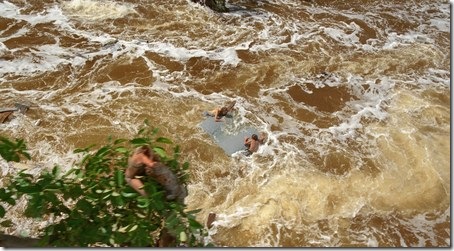As the bloodiest natural disaster of the aughts, the 2004 tsunami on the west coast of Asia needs a better movie than The Impossible. It had a much better one, in fact, in 2010’s Hereafter, of which Clint Eastwood’s expert rendering of the massacre was one of three sensitive stories connecting wayward souls. This time, there is no grace, no art, no intelligence, no cultural understanding: Just a rotating door of snuff, sentiment and narrative reductionism.
For thinking audiences, problems arise before the story itself does. The Impossible opens with a title card explaining the devastation of the tsunami and then informing us that the movie we’re about to see tells a true story of survival. Then all the words except “true story” fade into the blackness, further emphasizing the film’s veracity in order to … what? Protect itself from criticism that what we’re about to see is malarkey? It is malarkey, but we’ll get to that later.
A prologue like this is equally superfluous because it’s a suspense buzzkill. When I say that The Impossible is a story of a family surviving an apocalyptic disaster, I’m spoiling nothing that isn’t given away before the first shot fades into view. Watching the movie is like watching someone solve a math equation when we already know what the answer is (Movies like have United 93 have proved that foregone conclusions could still be thrilling and heartbreaking, but The Impossible is no United 93).
The first we see of the Bennett family – father Henry (Ewan McGregor), mother Maria (Naomi Watts) and children Lucas (Tom Holland), Thomas (Samuel Joslin) and Simon (Oaklee Pendergast) – is on an airplane heading to Thailand on Christmas Eve, 2004. There is a lot of turbulence in the descent, which Maria has trouble handling. Like everything else in this movie, the moment is a pure calculation, the first example of the director, Juan Bayona, playing us like two-bit fiddles while rewarding our foresight: Yeah, turbulence can be rough, but it’s nothing compared to what these people are about to suffer. Bravo. It isn’t the last time Bayona will use the grammar of the vulgar horror film to make an obvious point.
Two days later, of course, the tsunami crashes upon their Christmas vacation of spacious pools, white sand beaches and paper lanterns – paradise instantaneously lost, leaving only spasms of life in an endless canvas of debris. Bayona has a flair for this material, and the reproduction of the storm is the least-objectionable element of The Impossible. The action is truly harrowing, the pace unrelenting, the destruction appropriately incomprehensible. It’s hard to watch in the best way possible, and in the sheer terror spreading across the actors’ faces, the movie finds its lone semblance of truth.
After managing to connect in the waves’ aftermath, Maria and Lucas navigate the destruction. Maria is terribly wounded, with a gash in her leg spilling blood, and she’s on the brink of death when she’s admitted to a hospital that’s in a state of pandemonium. Bayona continues to wallow in all manner of blood, gore and gruesomeness, rubbing our spoiled western faces into the reality – his reality – of the storm’s wrath. In any other context, stripped of its “true story” prestige, The Impossible would be decried as torture porn, with Bayona its sadistic perpetrator.
To be clear, I have no doubt that the bloodletting, death and injury from the Indian Ocean tsunami was on an inhuman scale, but Bayona’s m.o. is sensationalism, not docudrama. I don’t need to see Naomi Watts vomiting bloody seaweed under the symphonic strains of suspense music to comprehend the disaster.
We soon discover that reveling in carnage is one of two poles of extremity in which The Impossible resides, and the other is more odious: the sentimental weepie. No moment is beyond the pale for tear-jerking; it’s why the movie exists. Blatant and shameless in his orchestration of tragedy, Bayona relies on Fernando Velazquez’s turgid score like an alcoholic relies on booze, bringing in more and more of it whenever any emotion takes hold.
Bayona is endowed with Spielberg’s worst tendencies to sentimentalize but with none of his gripping tact and genuine care for his creations. In The Impossible, the Bennett family members are cheap instruments to be played, just like the film’s audience, their performances buried under a swollen soundtrack that, contrary to its intentions, alienates us from the action. If the movie is occasionally moving from time to time, it’s in spite of itself. Thank Naomi Watts’ performance for transcending the clatter.
But the most offensive element of The Impossible is that, in the tradition of The Last King of Scotland, Hollywood once again insists on filtering a foreign tragedy through the “accessible” lens of a privileged white family. The shattered lives of the Thai natives are explored in mere seconds of screen time, their presence reduced to that of silent, saintly helpers. And the kicker? The real-life family that survived the tragedy was Spanish, not Anglo, but I guess that would have been a tougher sell for the studio.
But it’s a true story, you betcha! Nothing like a good old-fashioned whitewashing to make the eyes of our dwindling western majority population relate to the devastation.
THE IMPOSSIBLE. Director: Juan Bayona; Cast: Naomi Watts, Ewan McGregor, Tom Holland, Samuel Joslin, Oaklee Pendergast; Distributor: Summit; Rating: PG-13; Opens: Today at Cinemark Palace in Boca Raton, Muvico Parisian in West Palm Beach, Regal Royal Palm in Royal Palm Beach, Muvico Pompano in Pompano Beach, Regal Oakwood in Hollywood and other area theaters.
